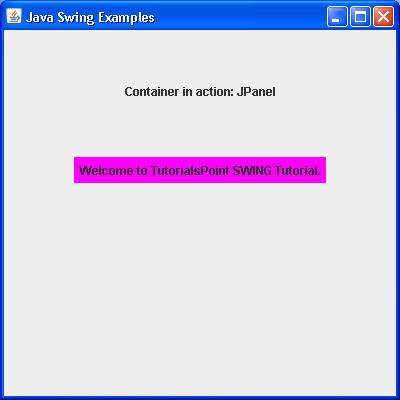
SWING - JPanel Class
Introduction
The class JPanel is a generic lightweight container.
Class Declaration
Following is the declaration for javax.swing.JPanel class −
public class JPanel
extends JComponent
implements Accessible
Class Constructors
| Sr.No. | Constructor & Description |
|---|---|
| 1 |
JPanel() Creates a new JPanel with a double buffer and a flow layout. |
| 2 |
JPanel(boolean isDoubleBuffered) Creates a new JPanel with FlowLayout and the specified buffering strategy. |
| 3 |
JPanel(LayoutManager layout) Creates a new buffered JPanel with the specified layout manager. |
| 4 |
JPanel(LayoutManager layout, boolean isDoubleBuffered) Creates a new JPanel with the specified layout manager and buffering strategy. |
Class Methods
| Sr.No. | Method & Description |
|---|---|
| 1 |
AccessibleContext getAccessibleContext() Gets the AccessibleContext associated with this JPanel. |
| 2 |
PanelUI getUI() Returns the look and feel (L&F) object that renders this component. |
| 3 |
String getUIClassID() Returns a string that specifies the name of the L&F class which renders this component. |
| 4 |
protected String paramString() Returns a string representation of this JPanel. |
| 5 |
void setUI(PanelUI ui) Sets the look and feel (L&F) object that renders this component. |
| 6 |
void updateUI() Resets the UI property with a value from the current look and feel. |
Methods Inherited
This class inherits methods from the following classes −
- javax.swing.JComponent
- java.awt.Container
- java.awt.Component
- java.lang.Object
JPanel Example
Create the following Java program using any editor of your choice in say D:/ > SWING > com > tutorialspoint > gui >
SwingContainerDemo.java
package com.tutorialspoint.gui;
import java.awt.*;
import java.awt.event.*;
import javax.swing.*;
public class SwingContainerDemo {
private JFrame mainFrame;
private JLabel headerLabel;
private JLabel statusLabel;
private JPanel controlPanel;
private JLabel msglabel;
public SwingContainerDemo(){
prepareGUI();
}
public static void main(String[] args){
SwingContainerDemo swingContainerDemo = new SwingContainerDemo();
swingContainerDemo.showJPanelDemo();
}
private void prepareGUI(){
mainFrame = new JFrame("Java Swing Examples");
mainFrame.setSize(400,400);
mainFrame.setLayout(new GridLayout(3, 1));
mainFrame.addWindowListener(new WindowAdapter() {
public void windowClosing(WindowEvent windowEvent){
System.exit(0);
}
});
headerLabel = new JLabel("", JLabel.CENTER);
statusLabel = new JLabel("",JLabel.CENTER);
statusLabel.setSize(350,100);
msglabel = new JLabel("Welcome to TutorialsPoint SWING Tutorial.", JLabel.CENTER);
controlPanel = new JPanel();
controlPanel.setLayout(new FlowLayout());
mainFrame.add(headerLabel);
mainFrame.add(controlPanel);
mainFrame.add(statusLabel);
mainFrame.setVisible(true);
}
private void showJPanelDemo(){
headerLabel.setText("Container in action: JPanel");
JPanel panel = new JPanel();
panel.setBackground(Color.magenta);
panel.setLayout(new FlowLayout());
panel.add(msglabel);
controlPanel.add(panel);
mainFrame.setVisible(true);
}
}
Compile the program using the command prompt. Go to D:/ > SWING and type the following command.
D:\SWING>javac com\tutorialspoint\gui\SwingContainerDemo.java
If no error occurs, it means the compilation is successful. Run the program using the following command.
D:\SWING>java com.tutorialspoint.gui.SwingContainerDemo
Verify the following output.
